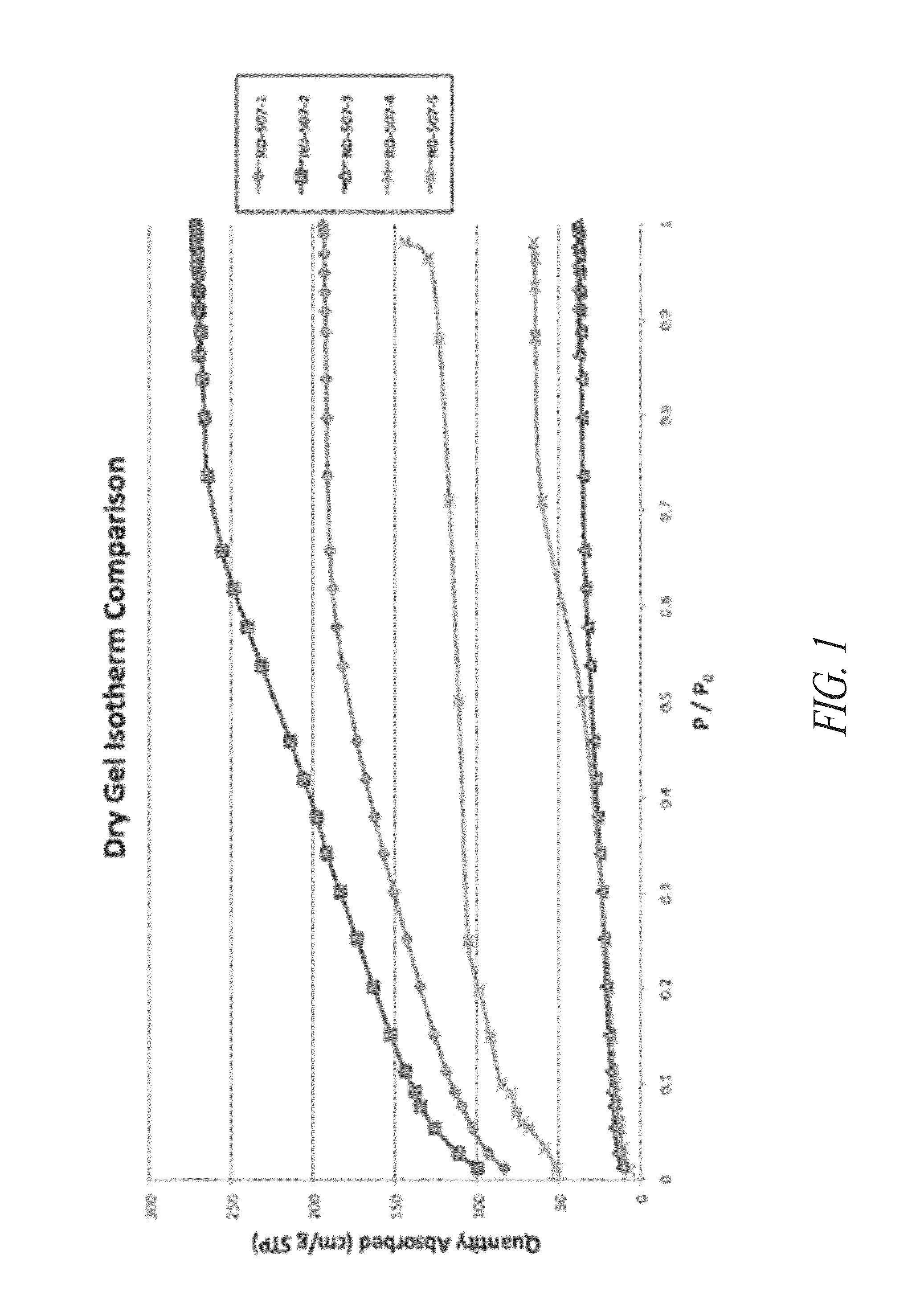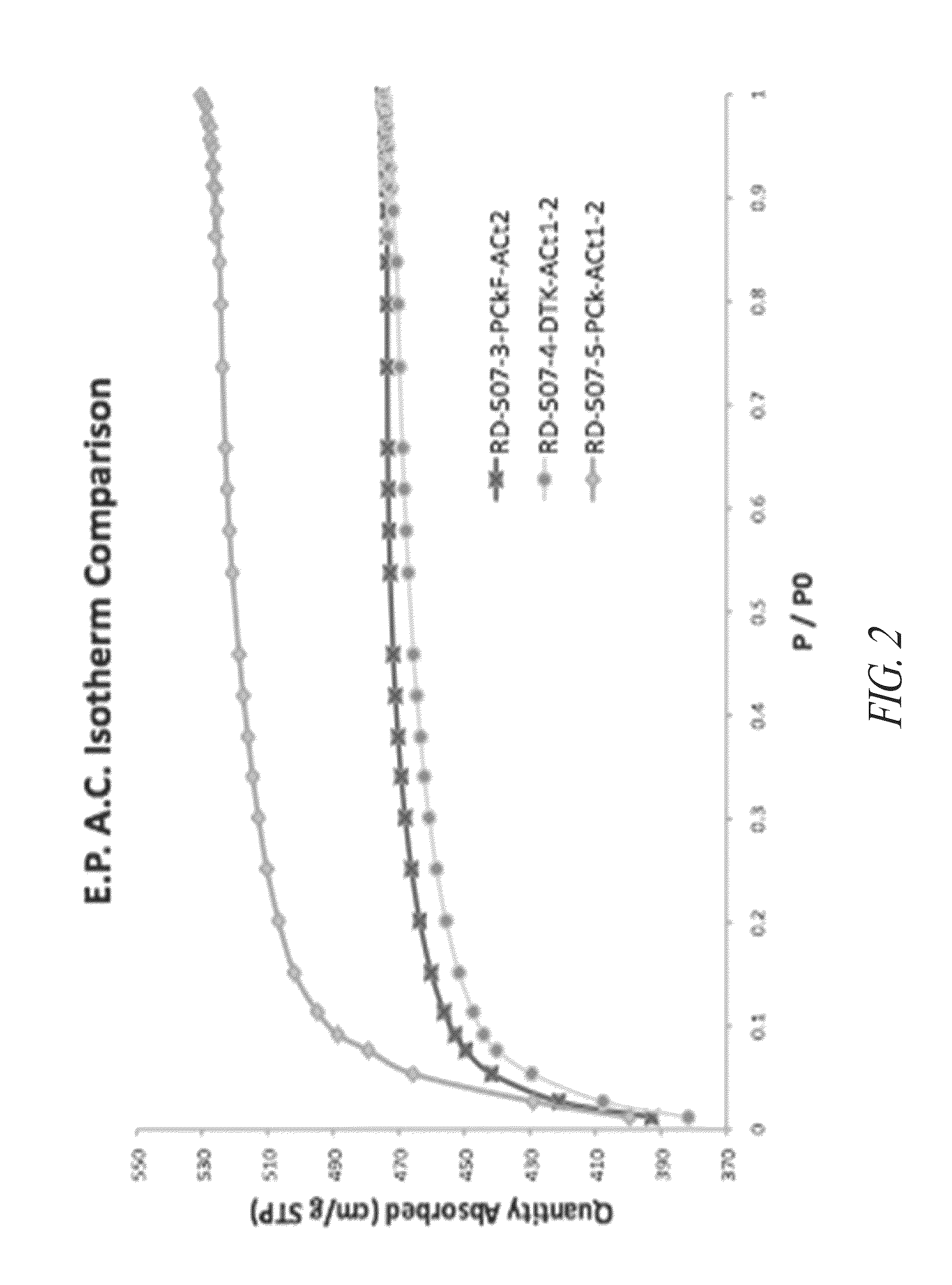Preparation of polymeric resins and carbon materials
a technology of polymeric resin and carbon materials, applied in the field of methods, can solve the problems of edlcs and carbon-based batteries, decreased performance at high temperature, repeated charge/discharge cycles, and increased cos
- Summary
- Abstract
- Description
- Claims
- Application Information
AI Technical Summary
Benefits of technology
Problems solved by technology
Method used
Image
Examples
example 1
Emulsion Preparation of Dried Polymer Gel
[0406]For each sample, two separate solutions were prepared. Five different gel solutions were made by admixing a resorcinol and formaldehyde (molar ratio of resorcinol:formaldehyde=0.5:1) solution with a water / acetic acid solvent (75:25) and adding an ammonium acetate catalyst. The ratios of the various gel reagents are indicated in Table 1 for the five samples. A cyclohexane / SPAN 80 solution was also prepared.
[0407]The gel solution was allowed to mix for 10 minutes before it was poured into the cyclohexane / SPAN80 solution and the temperature was set to 45° C. After 4 hours at 45° C., the temperature was increased to 65-70° C. and held for 24 hours before the excess cyclohexane was decanted and the resin was placed in a 45° C. oven for 10-20 minutes to dry. Sample conditions are summarized in Table 1.
[0408]
TABLE 1Polymerization ConditionsRFGel FormulationSolutionCyclohexaneSPAN80%Sample(Solids / Acid / R:C)*(mL)(mL)(mL)% SPAN80Gel**RD-507-141 / 20...
example 2
Dried Polymer Gel Data
[0409]Nitrogen isotherm, surface area and pore volume data for the dried gel samples from Example 1 are presented in FIG. 1 and in Table 2. For comparative purposes, two carbon samples were prepare as controls via the general “monolith” approach described in Example 15. Comparative Sample 1 was prepared from a gel formulation having a Solids / Acid / R:C ratio of 40 / 20 / 10 and Comparative Sample 2 was prepared from a gel formulation having a Solids / Acid / R:C ratio of 33 / 20 / 20. All samples showed a lower surface area and pore volume compared to the comparative samples. While not wishing to be bound by theory, it is thought that this decrease is likely due to surfactant in the pores and on the surface of the gel material, and was expected to be burned off during pyrolysis. This theory was supported by the ability to activate the pyrolyzed material to a target surface area, pore volume, and P95 / P5 (i.e., ratio of nitrogen sorbed at 95% partial pressure to that sorbed at...
example 3
Activated Carbon Data
[0411]Nitrogen isotherm, surface area, pore volume, and electrochemical testing (ECT) data for activated carbon samples (RD-507-3, -4, -5) are presented in FIG. 2 and in Tables 3 & 4. Samples 3 and 5 were pyrolyzed at 900° C. in a kiln and held for 60 minutes at this temperature and sample 4 was pyrolyzed without any drying step prior to pyrolysis (Wet Gel −60 minutes at 625° C., unless stated otherwise all other gels were freeze dried prior to pyrolysis). All three samples were activated at 900° C. in a tube furnace (CO2 atmosphere) to achieve a surface area of 1700-1900 m2 / g. The isotherm data (FIG. 2) shows that all three samples were very microporous carbon and had a surface area to pore volume development comparable to a control carbon material prepared via monolith techniques. All samples also demonstrate ECT performance comparable to a comparative carbon prepared via monolith techniques (Comparative Sample 3) (24 F / cc at the time). Although the gel formul...
PUM
| Property | Measurement | Unit |
|---|---|---|
| mean particle diameter | aaaaa | aaaaa |
| mean particle diameter | aaaaa | aaaaa |
| volume average particle size | aaaaa | aaaaa |
Abstract
Description
Claims
Application Information
 Login to View More
Login to View More - R&D
- Intellectual Property
- Life Sciences
- Materials
- Tech Scout
- Unparalleled Data Quality
- Higher Quality Content
- 60% Fewer Hallucinations
Browse by: Latest US Patents, China's latest patents, Technical Efficacy Thesaurus, Application Domain, Technology Topic, Popular Technical Reports.
© 2025 PatSnap. All rights reserved.Legal|Privacy policy|Modern Slavery Act Transparency Statement|Sitemap|About US| Contact US: help@patsnap.com



